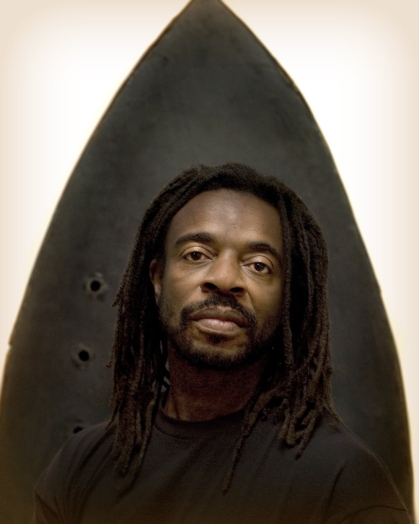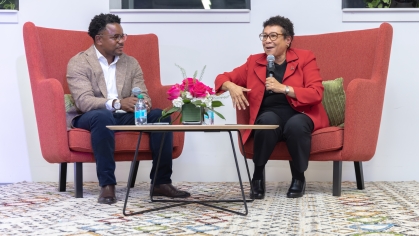At the Close of His Express Newark Residency, Willie Cole Reflects on His Art

Known for transforming discarded objects into art, Willie Cole has inspired others to find beauty in things that seem useless and unwanted.
“To be in a space with him is to see the world differently,’’ said Salamishah Tillet, executive director of Express Newark, where Cole completed his one-year artist residency this summer.
During his time at Express Newark, a socially engaged center for art and design supported by Rutgers-Newark, Cole, who grew up in the city, used thousands of plastic water bottles to create chandeliers and 30-foot-tall figurative sculptures.
Newark residents and art students from the School of Arts and Sciences-Newark helped with the pieces, drilling holes in bottles so they could be threaded with wire. They followed Cole--who has an international reputation as an artist—through the process of design and creation.
In the past, Cole has employed the bottles to draw attention to Newark’s water crisis, when lead was found to be contaminating water and residents were given plastic water bottles until it was removed. His sculptures are also a commentary on the environmental damage caused by the proliferation of plastic water bottles in recent decades.
The pieces he created at Express Newark include a chandelier that hangs in the center’s lobby and another above the staircase of the Hahne Building, where Express Newark is located. Four additional chandeliers, some incorporating images of Buddha and the Statue of Liberty inside each bottle, were installed along Park Avenue in Manhattan between 69th and 70th Streets, one of the city’s wealthiest blocks.
For Cole, they are an inversion of the neighborhood’s interior decor.
“On Park Avenue, they have chandeliers inside the apartments,” he said.
According to Cole, the Fund for Park Avenue, which commissioned the work, normally chooses sculptures mounted on pedestals, so his sculptures were a radical departure.
At Express Newark, Cole’s residency was part of a year-long exploration of the theme “Aliveness,” which has informed the center’s programming of art installations, lessons, studio sessions and community classes. The center’s leaders were inspired by scholar Kevin Quashie’s recent book, “Black Aliveness, or a Poetics of Being.”
Cole praised Express Newark for sparking creativity and experimentation. “It’s a great space,’’ he said. “It’s a place to play around and be exposed to things.’’
In addition to creating art, Cole co-taught classes alongside artist Colleen Gutwein, an American Studies graduate student and lecturer in the Department of Arts, Culture and Media, and Keary Rosen, director of the Form Design Studio, which was a co-host of Cole’s residency and will to continue to work with him on art projects.
One of Cole’s missions as a teacher was to give students a sense of what it’s like to be a professional artist, a career in which being self-directed is crucial. “Once you graduate from school, your full-time job is just being the artist that you think you are,’’ he said. “Your job is doing the art that you assign yourself.’’
As part of that class, Cole came up with the prompt behind an exhibition titled “Perceptual Engineering,’’ in which students and regional artists were asked to repurpose discarded, everyday objects, creating something new out of the objects’ parts. The exhibition, along with Cole’s chandeliers, received coverage from the New York Times.
Cole says working with one type of object is a way of challenging himself to explore the many ways it can be reimagined. In addition to bottles, he has made sculptures from shoes, saxophones and ironing boards. Many of his most well-known pieces reference African art.
“Using multiple objects to create a single thing offers little or no challenge for me as an artist,’’ says Cole. “Using a single object, however, has helped me develop a higher level of creativity, imagination and perception."
During an artist’s talk this month with Newark artist Adrienne Wheeler, who has been friends with Cole since their teens, he was hesitant to identify a “Newark school” of art. But he observed that many city artists have created work from found objects, in part because paint and canvas can be costly.
He said Newark is on a “good flow, a good journey” for artists and that Express Newark was proof of that.
“It’s important,’’ said Cole. “It shows that the city supports the arts.’’


